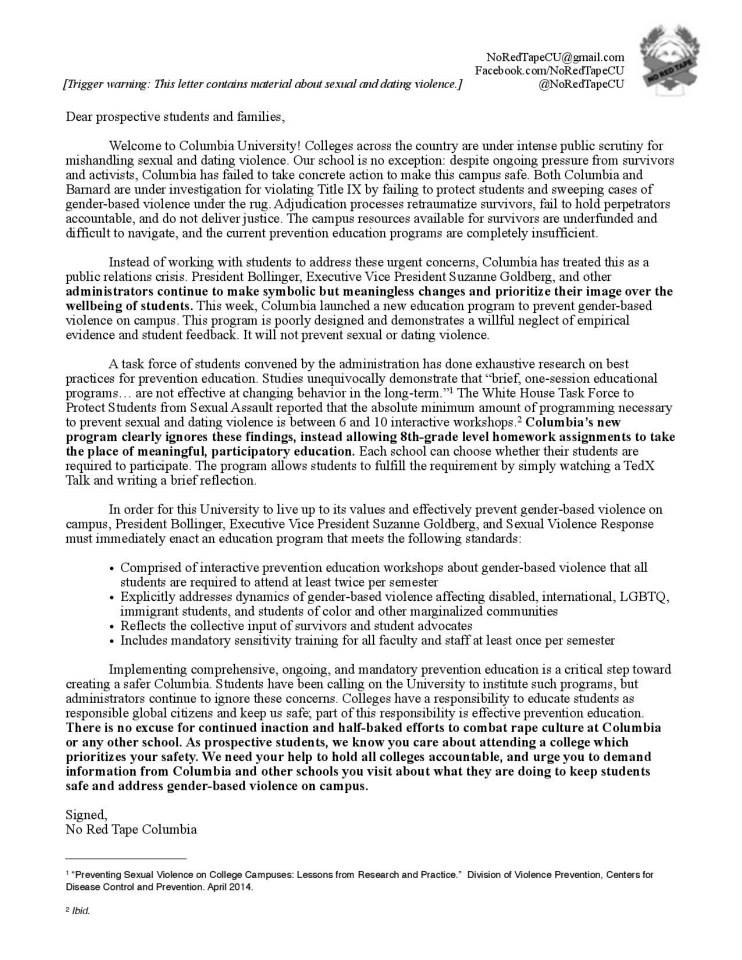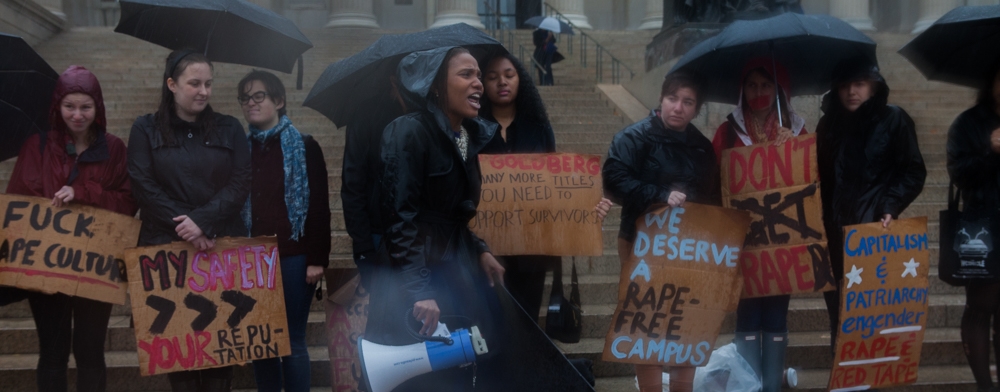History
In January 2013, Barnard College senior Anna Bahr published a series of articles in The Blue and White, a campus publication, detailing various students’ experiences with sexual assault on the Columbia campus. The articles exposed an institution dedicated more to protecting its image than ending sexual assault and helping survivors. This started a conversation about sexual assault at Columbia. Many survivors began to see how their own individual experiences fit within a much larger, systemic problem—one enabled and excused by deeply rooted cultural and institutional factors.
Spring 2014
As survivors and students saw the prevalence of these issues, the need for change felt imperative. They formed the Coalition Against Sexual Violence and began to fight Columbia’s inadequate Policy on Gender-Based Misconduct. Soon after, students founded No Red Tape to use radical means to create radical change. These two groups knew that neither strategy would be enough alone; they had to work together to eliminate the bureaucratic red tape that silences survivors’ voices.
At the end of February 2014, members of the newly-formed No Red Tape posted flyers with red tape all over campus as a visual reminder of what the Columbia administration does (or rather, does not do) behind closed doors. They called for a town hall meeting to address their grievances. The town hall meeting was eventually granted, though the grievances were far from addressed. During Days on Campus in March, No Red Tape tried to hand out letters advising admitted students about Columbia’s sexual assault policy. They covered their mouths with red tape, but the symbolism proved unnecessary when the administration promptly kicked them out. The media picked up on the story, and Columbia’s shame received national attention.
On April 24, 2014, 28 survivors filed Title IX, Title II, and Clery Act complaints against Columbia and Barnard. Thousands of alumni, horrified with the University, stopped donating.
Around this time, No Red Tape began recognizing a need for more community-based services. They started offering support for survivors, such as case management, where they helped survivors obtain whatever they needed to feel safe on campus and directed survivors to other resources, such as the independent peer support group Survivor’s Circle. They also realized that this problem needed long term solutions that would lessen rates of violence. No Red Tape started running prevention programs, from consent workshops with incoming first-years to bystander intervention in local bars to trainings on consent community accountability with student groups.
Fall 2014
The University unveiled a new gender-based misconduct policy on August 15, 2014. Despite constant student pressure the previous spring, administrators failed to include any students in the revision process. As NRT read through the policy, it became clear that the changes were a response to new federal legislation and barely incorporated any student feedback.
On September 9, 2014, a group of students, including representatives of No Red Tape, delivered a list of policy proposals to Columbia President Lee Bollinger and asked for a response within three weeks. Three days later, No Red Tape held its first rally, Stand With Survivors. Over fifty survivors spoke out about their experiences with sexual violence. More than a hundred students listened in an astounding show of solidarity.
October 29, 2014 saw No Red Tape’s biggest action yet. In conjunction with Carrying the Weight Together, NRT organized a national Day of Action inspired by the artwork of Emma Sulkowicz. Participants at over 140 schools, from Central European University in Budapest to Stanford University in California, carried mattresses for the day. On Columbia’s campus, No Red Tape organized another rally on Low Steps. At the end of the rally, students marched to President Bollinger’s house and left 28 mattresses on his doorstep. One mattress listed out the group’s demands and the rest were signed by hundreds of members of the Columbia community who pledged to support survivors and called on President Bollinger to do the same. The administration threw the mattresses in the dumpster within an hour and charged No Red Tape for the cleanup costs.
A couple of weeks later, the Fund for a Safer Columbia launched. The Fund is an non-profit whose goal is to provide funding for sexual assault activism and prevention on campus.
Fall 2015
On October 28, 2015, No Red Tape held a rally focused on the intersection between institutionalized discrimination and sexual violence on campus. No Red Tape and over a dozen other student groups then presented school administrators with a list of demands aiming to increase Columbia's support, accessibility, accountability, funding, and enforcement, particularly addressing the experiences of marginalized survivors.
Following the rally in October, No Red Tape joined forces with other student activist groups on campus engaging in escalation campaigns. These groups soon formed the Barnard Columbia Solidarity Network, a group mobilizing in a common struggle for liberation.
On December 7, 2015, the Barnard Columbia Solidarity Network, including No Red Tape, held a rally with demands focused on racial justice, particularly the experiences of Black students and students of color, as well as Black communities and communities of color near Columbia. These demands included a 24/7 rape crisis center, increased student wages, and institutional accountability for those affected by Columbia's expansion.
Spring 2016
On March 2, 2016, Columbia's Dean of Undergraduate Student life Cristen Kromm called sexual violence a "mistake" and an opportunity for a perpetrator's "learning, growth, and change." No Red Tape quickly started a petition demanding an apology. After a successful petition drop, Dean Kromm issued an apology.
Building off of momentum from the petition, No Red Tape applied to be recognized as an official student group at Columbia. On March 22, 2016, after receiving a recommendation from Columbia's Student Governing Board, No Red Tape was approved for recognition.
Fall 2016
In September 2016, Columbia University began passing out a contract banning students taking part in the gender-based misconduct process from recording the proceedings under threat of facing Dean's Discipline. If students refused to sign the contract, Columbia said they would not investigate the student's case in violation of Title IX.
In response, No Red Tape formally launched the #RightToRecord campaign on September 29, 2016. The campaign demanded the University allow students to record investigations, hearings, and appeals in the name of transparency. Despite the Columbia administration refusing to back off and EVP Goldberg insisting the recording ban was to protect students, the petition quickly garnered more than 740 signatures and over 20 co-sponsoring groups.
On October 28, 2016, No Red Tape held a rally demanding the right to record. During the rally, students shared recordings of their gender-based misconduct investigations in violation of Columbia's recording policy. No Red Tape subsequently brought this to the attention to Student Conduct and Community Standards, the office in charge of enforcing the recording contract.
On December 10, 2016, No Red Tape projected phrases such as "How Many OCR Complaints Will It Take?" and "Black Survivors Matter" on Low Library to draw attention to Columbia continuing to mistreat survivors of sexual and dating violence on campus.
To learn more about how to get involved with No Red Tape's work, click here.
















